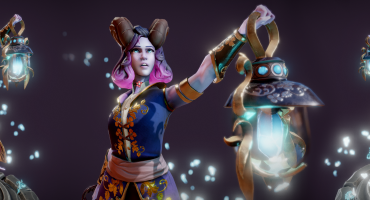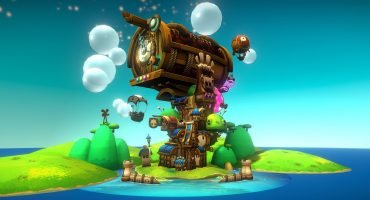In Art Spotlight, we invite Sketchfab artists to talk about one of their designs.
Hi everyone,
I’m Sander Vander Meiren, a passionate Environment Artist currently studying at Digital Arts and Entertainment (Howest) in Belgium. With this education I want to master environment art for games.
The trend throughout my portfolio is “modularity” since this term is one of the most, if not the most, important in order to describe environment art.
This project was my final exam entry for the “Stylized Game Graphics course”. The goal of the assignment was to create your own concept of a stylized building and translate it into 3D. I tried to make a coherent scene that feels nice and joyful.
Concept phase
Every scene needs a good concept, I have to admit that I’m not that great of a concept artist so finding a good composition/concept was a real struggle for me. I started out designing a small house, but it looked too dull. For the second sketch I used the same base, but I designed a different building. Only this time I designed it with a backstory in mind (an adventurers store: “emporium o’ stuff”). But this didn’t really work out. Again, I started from scratch. Better to start anew than to keep working on a concept you’re not completely convinced with. I was really inspired by the amazing tower artwork of Artyom Vlaskin and the art of the movie “Tangled”. I decided to go with a floating player base! This design seemed to work best for me so I moved on to modeling.
Block out/modeling phase
For the block out phase of this scene I tried to work as smart and fast as possible while thinking about big, middle and small shapes. First I tried to get the big shapes nailed down so I had a main idea of how the composition was going to look. I had some struggles doing this for the house since the round tower base is not ideal to make a house structure. I fixed this by curving the house slightly so it fits the round shape of the base while still looking like a house.
Then I moved on to the middle shapes. In this phase I started adding some more life to the scene: wooden poles to support the structure, some tree roots curling around the rocks, etc. To create trees I developed a good modular technique. I used splines to define all shapes and after that I made a loft compound object from it and to finish it off I added an edit poly modifier on top of it. Doing so I could tweak the geometry of the tree with edit poly. If I wanted to edit the shape or flow, I could change the spline so the roots follow the desired curve, maintaining the geometry.
After I completed the middle shapes I decided it was time to start editing the block out I already had to make the shapes look polished. When this phase was done I started making modular small pieces to fill my scene. E.g. Grass, ferns, some more wood, branches, loose stones, etc.
Unwrapping/Texturing
While working on this scene, I combined these 2 processes. After the modeling I immediately started making tileable textures. This way, my scene started to look way more interesting and filled. I could also re-use certain parts from my tillable to save time texturing my unique models.
This made a lot of the unwrapping very easy and fast. Since I wanted to give my roof more dimension I extruded some roof tiles with edit poly while preserve UV’s was on.
When I finished with the tillable textures, I moved on to the unique models. As I mentioned before, I could re-use some planks and stones. This process was achieved in Adobe Photoshop.
To speed up the texturing of the rocks I used 3d coat since this program works really well for texturing organic models.
Then the fun part started. Now everything is textured, I spammed plants, rocks, planks and branches everywhere while still thinking about logical placing of the grass and stones. This made the composition of everything in the scene feel way more realistic.
Finishing touches
Before uploading to Sketchfab, you need to prep your model in your 3D application. Some things you need to do but most of the times forget:
- Name your materials: this makes it easy to edit them in Sketchfab.
- Merge all objects with the same materials: this is something small, but It greatly improves the performance in the real-time viewer.
- Reset Xforms on all your objects, the objects you placed will stay put while exporting.
Then it was time to upload my work onto Sketchfab. I personally find it the easiest to export it as FBX and add the materials afterwards since I like to tweak the fbx settings to my preference. The final step is post processing, lighting, and making a thumbnail. First I like to make a nice light setup, I like to use the standard 3 point lighting method.
The 3d settings of Sketchfab contains a wide array of post processing options. I played around with it until I was happy with the result.
Last but not least, the thumbnail. This may be one of the most important things in your presentation; this is the first thing people see. This needs to be inviting to click on.
Some advice:
- Use an interesting view capturing the essence of your scene
- Give it some contrast! This advice is the same for renders as this makes your image more likable
Want to visit this scene in its full glory?
Staying motivated
Motivation is hard to come by especially when you get stuck while working on a project. To prevent this I made a Twitch channel to be able to talk to people while working on my projects.
So many people underestimate how big of a role social contact plays in work. Sometimes you get awesome feedback or help which will improve your work even more.
Sharing = caring
I started sharing my models on Sketchfab because it’s an amazingly helpful tool to show your work to the world. It’s so much faster than opening your 3d application (which few people have) and showcasing it there. I also started making my models downloadable, since I want people to be able to see my work in depth or maybe get some inspiration.
Thanks Guys!
I would like to thank everyone for the amazing support on my work and especially Sketchfab for creating an opportunity for 3D artists to share their work at its best! Thanks for reading!
Thanks Sander!
You can see more of Sander’s work here on Sketchfab and on his online portfolio and ArtStation.








